
home \ courses \ music theory III \ page 5
Seventh chords
When you add a fourth tone to a triad, you get a "seventh" chord". That is because the added note is a seventh (interval) from the ground tone.
Let's look at an example: C major seventh.
This is a major triad + a major seventh:
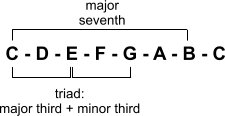
If you use the interval approach, you can split this major 7th chord into the following intervals:
- C - C: perfect unison
- C - E: major third
- C - G: perfect fifth
- C - B: major seventh
As we saw before, the third can be major(3) or minor(3b), the fifth can be perfect(5), diminished(5b) or augmented(5#). To this we can add that the seventh can be minor(7b) or major(7). or diminidhed(7bb).
Before we look at all possible combinations, let's take the same chord, and look at it using the "thirds approach":

So this is the same chord. You can see that a seventh chords - just as triads - are an accumulation of thirds. If you add a third (minor or major) to a triad, you get a seventh chord.
Different Seventh chords
By combining different thirds, fifths and seventh, or by accumulating major and minor thirds, you get different types of seventh chords. We will look at the seven common ones. All examples are based on C.
Major 7th
Ground tone + major third + perfect fifth + major seventh, or
Ground tone + major third + minor third + major third
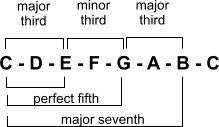
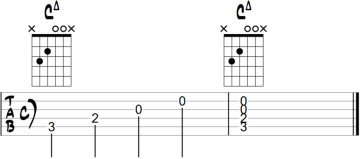
Note that the chord symbal for major 7th is a little triangle. Sometimes a capital M and a seven is used instead: CM7.
Dominant 7th
Ground tone + major third + perfect fifth + minor seventh, or
Ground tone + major third + minor third + minor third
This is called "dominant 7th", because it has a very dominant urge to resolve harmonically, it wants to "go somewehere".
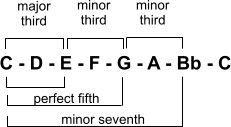
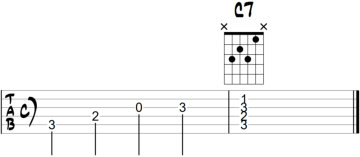
The tones of a dominant 7th chord cannot be played in order and simultanious on guitar. The tones are sorted differently to be able to play all of them.
(So the order is not C-E-G-Bb, but, in this case, C-E-Bb-C, the G is ommited.) The fact that tones cannot be played in order is quit common on guitar.
Sometimes less important tones are ommited, like the fifth, or the ground tone (the bass player often already plays the ground tone).
There is no special symbol for th dominant 7. If only a 7 is written, it means dominant 7th.
Minor 7th
Ground tone + minor third + perfect fifth + minor seventh, or
Ground tone + minor third + major third + minor third
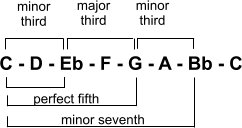
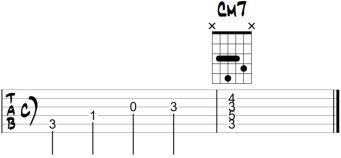
Minor/Major
Ground tone + minor third + perfect fifth + major seventh, or
Ground tone + minor third + major third + major third

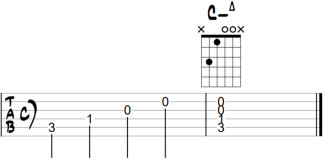
Note the chord symbol. Here it is a C with a dash, meaning "minor". The little triangle means "major 7th". So it is a C minor chord with a mjor 7th.
Sometimes it is written as "C minmaj". You might find more exotic names, like "B+/C". These are not official names, but exist because some computer programs lack the minmaj chord.
(B+/C means B augmented with a C in the bass, which results in a set of tones that is enharmonic the same as C minmaj).
Diminished 7th
Ground tone + minor third + diminished fifth + diminished seventh, or
Ground tone + minor third + minor third + minor third
Note: it's an accumulation of minor thirds only.
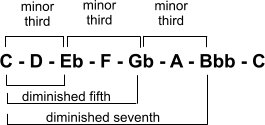
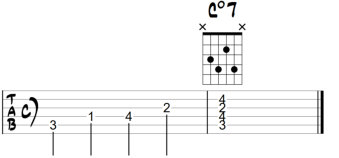
The symbol for a diminished chord is a little circle.
Half Diminished
Ground tone + minor third + diminished fifth + minor seventh, or
Ground tone + minor third + minor third + major third
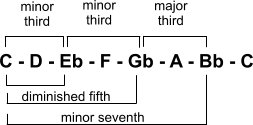
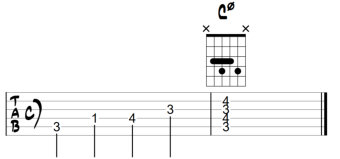
The symbol for a halfdiminished chord is a little circle, splitted with a diagonal line.
Augmented 7th
Ground tone + major third + augmented fifth + major seventh, or
Ground tone + major third + major third + minor third

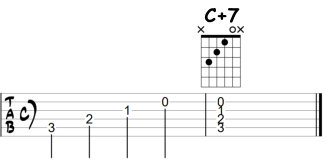
Next: what 7th chords are in the major and minor scale?
<<< Previous page | Next page >>>